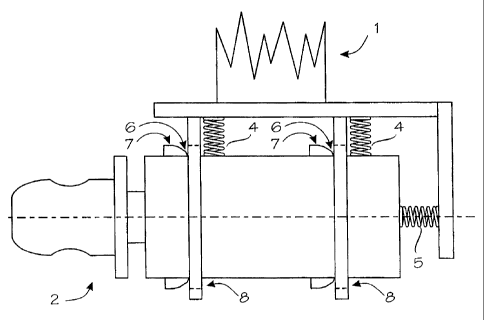Some of the information on this Web page has been provided by external sources. The Government of Canada is not responsible for the accuracy, reliability or currency of the information supplied by external sources. Users wishing to rely upon this information should consult directly with the source of the information. Content provided by external sources is not subject to official languages, privacy and accessibility requirements.
Any discrepancies in the text and image of the Claims and Abstract are due to differing posting times. Text of the Claims and Abstract are posted:
| (12) Patent: | (11) CA 2349254 |
|---|---|
| (54) English Title: | ARRANGEMENT FOR WINDING CABLES OR THE LIKE |
| (54) French Title: | SYSTEME D'ENROULEMENT DE CABLES OU ANALOGUES |
| Status: | Expired |
| (51) International Patent Classification (IPC): |
|
|---|---|
| (72) Inventors : |
|
| (73) Owners : |
|
| (71) Applicants : |
|
| (74) Agent: | CASSAN MACLEAN IP AGENCY INC. |
| (74) Associate agent: | |
| (45) Issued: | 2007-07-24 |
| (86) PCT Filing Date: | 1999-11-11 |
| (87) Open to Public Inspection: | 2000-05-25 |
| Examination requested: | 2004-08-23 |
| Availability of licence: | N/A |
| (25) Language of filing: | English |
| Patent Cooperation Treaty (PCT): | Yes |
|---|---|
| (86) PCT Filing Number: | PCT/FI1999/000937 |
| (87) International Publication Number: | WO2000/029316 |
| (85) National Entry: | 2001-05-01 |
| (30) Application Priority Data: | ||||||
|---|---|---|---|---|---|---|
|
The invention relates to an arrangement for winding a cable or the like on and
off a reel with a centre hole, which arrangement
comprises two movable, substantially vertical support arms (1), which are
supported by a frame structure and the free arm ends of which are
provided with spindles (2) arranged to be inserted to the centre holes of the
reel (3) between the support arms, when the support arms (1)
are being moved towards one another, whereby the reel can be raised from the
foundation by means of vertical adjustment of the support
arms (1) to enable the winding. To achieve a simple structure, the spindles
(2) are arranged floatably to the ends of the support arms (1)
allowing the spindles (2) to move freely in different directions. As a result
of the support arms moving towards one another and resting
against the centre hole of the reel (3), the spindles (2) are arranged to move
axially with respect to the support arms (1) into a position in
which the spindles (2) are locked to the support arms (1).
L'invention concerne un système de bobinage et de débobinage d'un câble ou analogue sur un touret comportant un trou central. Le système comprend deux bras de support (1) sensiblement verticaux, mobiles, qui sont maintenus par un cadre. Les extrémités libres desdits bras sont dotées de mandrins (2) destinés à être introduits dans les trous centraux du touret (3) entre les bras de support se déplaçant l'un vers l'autre. Le touret peut ainsi être soulevé de la base au moyen d'un ajustement vertical des bras de support (1) permettant l'enroulement. Afin d'obtenir une structure simple, les mandrins (2) sont montés flottants aux extrémités des bras de support (1), ce qui permet aux mandrins (2) de se déplacer librement dans différentes directions. Les bras de support, qui se déplacent l'un vers l'autre et qui s'appuient contre le trou central du touret (3), provoquent le déplacement axial des mandrins (2) par rapport aux bras de support (1) en une position dans laquelle les mandrins (2) se retrouvent bloqués contre les bras de support (1).
Note: Claims are shown in the official language in which they were submitted.
Note: Descriptions are shown in the official language in which they were submitted.

For a clearer understanding of the status of the application/patent presented on this page, the site Disclaimer , as well as the definitions for Patent , Administrative Status , Maintenance Fee and Payment History should be consulted.
| Title | Date |
|---|---|
| Forecasted Issue Date | 2007-07-24 |
| (86) PCT Filing Date | 1999-11-11 |
| (87) PCT Publication Date | 2000-05-25 |
| (85) National Entry | 2001-05-01 |
| Examination Requested | 2004-08-23 |
| (45) Issued | 2007-07-24 |
| Expired | 2019-11-12 |
There is no abandonment history.
Note: Records showing the ownership history in alphabetical order.
| Current Owners on Record |
|---|
| MAILLEFER S.A. |
| Past Owners on Record |
|---|
| LAUHDE, MIKA |
| NEXTROM HOLDING S.A. |
| SPIRT AVERT AG |